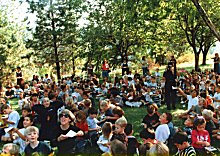![]()

Small Hands Tag & Release
|
School Kids Give Monarchs Royal Send-Off |
|
Schnell School Students Release Monarch Butterflies for Research Mountain Democrat, Placerville, California (10/20/99)
The research is being conducted by Swallowtail Farms in Woodland, owned by Jacob Groth, 28, a 1989 graduate of El Dorado High School. The farm is a butterfly breeding company, and researchers hope to learn more about the mysteries of how Monarchs migrate. Monarch butterflies do something no other insect is known to do - they migrate great distances in order to survive. In autumn, Monarchs fly as far south as Mexico. The Monarchs keep moving in their southern migration until they finally arrive where warmer weather conditions suit them for surviving the winter. In spring, new generations flock north again to find plants needed for their survival. There are still many unanswered questions about the Monarch migrations. How many generations of butterflies are involved in the southern and northern migrations? If several generations are involved, then why do these butterflies return to the same small winter sites year after year? How can they fly thousands of miles from where they emerged, to small groves of trees they have never seen, in a part of the country where they have never been? The autumn Monarchs are particularly interesting. They look exactly the same as the spring and summer Monarchs, but their bodies react differently and they behave differently. They feed heartily, storing fat to get through the long winter. They cease mating and migrate south and west almost immediately after they are able to fly. They may live as long as six months instead of the normal six weeks. One way researchers are learning more about Monarch butterflies is with tagging programs. Wildlife biologists have long tracked the movements of large animals like polar bears, wolves or mountain lions by attaching collars with radio transmitters. Butterflies are too small to carry radios. Researchers have to depend on ordinary people to help them trace the butterflies' movements. Butterfly tagging consists of putting two small orange tags on each lower wing of large numbers of insects. Each butterfly has its own serial number and a toll-free number for the finder to call and receive instructions. The hope is that people finding tagged butterflies will be good enough to help in the battle to preserve the Monarch. If you find a dead, tagged Monarch, you are asked to call the number on the tag. With living butterflies, the first rule is to not harm the insect. Researchers don't want Monarchs killed because they are tagged. If you can capture and release one without harming it, get the serial number and record the date and location of the encounter, and call the toll-free phone number. Research organizations that are doing the tagging will normally send you a letter in response, telling you when and where that particular butterfly was tagged. And you will get first-hand information about that one Monarch's migration history. Schnell School students have raised butterflies in recent years as part of their Garden of Learning program. The idea to have students participate in the release of tagged butterflies came from Swallowtail Farms. For students at Schnell, it was the highlight of a series of lessons on the wonders of the Monarch butterfly. |


